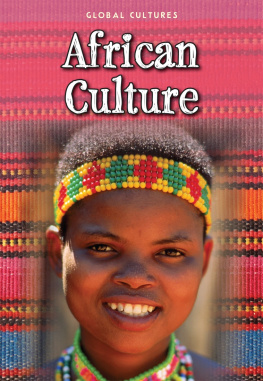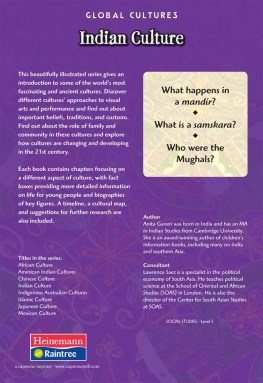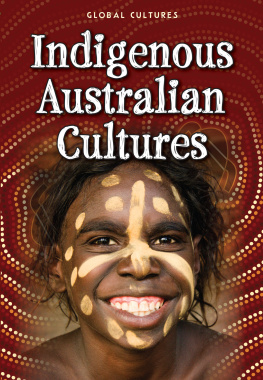Catherine Chambers - African Culture
Here you can read online Catherine Chambers - African Culture full text of the book (entire story) in english for free. Download pdf and epub, get meaning, cover and reviews about this ebook. year: 2012, publisher: Capstone, genre: Home and family. Description of the work, (preface) as well as reviews are available. Best literature library LitArk.com created for fans of good reading and offers a wide selection of genres:
Romance novel
Science fiction
Adventure
Detective
Science
History
Home and family
Prose
Art
Politics
Computer
Non-fiction
Religion
Business
Children
Humor
Choose a favorite category and find really read worthwhile books. Enjoy immersion in the world of imagination, feel the emotions of the characters or learn something new for yourself, make an fascinating discovery.
- Book:African Culture
- Author:
- Publisher:Capstone
- Genre:
- Year:2012
- Rating:3 / 5
- Favourites:Add to favourites
- Your mark:
- 60
- 1
- 2
- 3
- 4
- 5
African Culture: summary, description and annotation
We offer to read an annotation, description, summary or preface (depends on what the author of the book "African Culture" wrote himself). If you haven't found the necessary information about the book — write in the comments, we will try to find it.
African Culture covers a vast array of subjects on African culture from fine arts to ceremonies, from legends to the cultures global influence.
African Culture — read online for free the complete book (whole text) full work
Below is the text of the book, divided by pages. System saving the place of the last page read, allows you to conveniently read the book "African Culture" online for free, without having to search again every time where you left off. Put a bookmark, and you can go to the page where you finished reading at any time.
Font size:
Interval:
Bookmark:

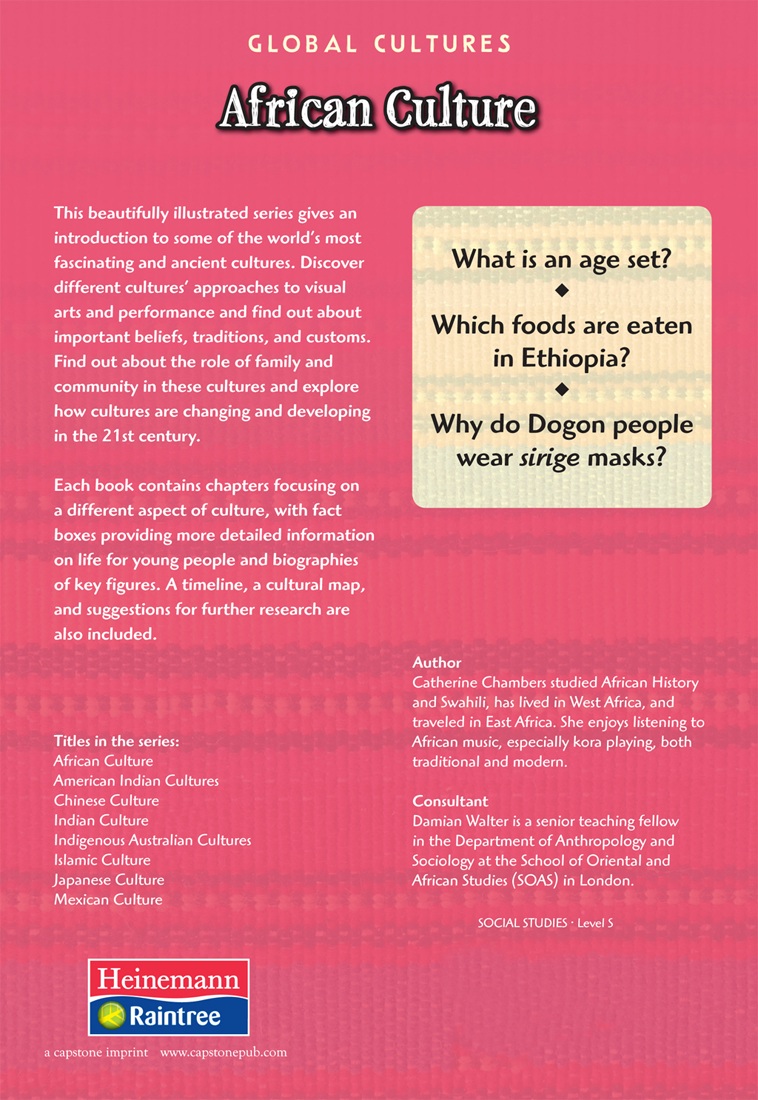

www.capstonepub.com
Visit our website to find out more information about Heinemann-Raintree books.
To order
Phone 800-747-4992
Visit www.capstonepub.com
to browse our catalog and order online.
2013 Heinemann Library an imprint of Capstone Global Library, LLC Chicago, Illinois
All rights reserved. No part of this publication may be reproduced or transmitted in any form or by any means, electronic or mechanical, including photocopying, recording, taping, or any information storage and retrieval system, without permission in writing from the publisher.
Edited by Charlotte Guillain, Abby Colich, and Vaarunika Dharmapala
Designed by Steve Mead
Original illustrations Capstone Global Library Ltd 2013
Illustrations by Oxford Designers & Illustrators
Picture research by Ruth Blair
Originated by Capstone Global Library Ltd
16 15 14 13 12
10 9 8 7 6 5 4 3 2 1
Library of Congress Cataloging-in-Publication Data
Chambers, Catherine.
African culture / Catherine Chambers.1st ed.
p. cm.(Global cultures)
Includes bibliographical references and index.
ISBN 978-1-4329-6776-5 (hb)ISBN 978-1-4329-6785-7 (pb)
ISBN 978-1-4846-1126-5 (eBook)
1. AfricaCivilization Juvenile literature. I. Title. II. Series: Global cultures (Chicago, Ill.)
DT14.C473 2013
960dc23 2011037700
Acknowledgments
We would like to thank the following for permission to reproduce photographs: Alamy pp. 5 ( Visions of America, LLC), 6 ( LatitudeStock), 12 ( Picture Contact BV), 13 ( John Warburton-Lee Photography), 14 ( Tom Gilks), 16 ( FORGET Patrick/sagaphoto. com), 27 ( Sabena Jane Blackbird); Corbis pp. 9 ( Antonio Silva/EPA), 15 ( Dai Kurokawa/EPA), 19 ( Patrick Durand/Sygma), 23 ( Bob Krist), 31 ( Gavin Hellier/JAI), 37 ( Ann Johansson), 38 ( David Atlas/Retna Ltd), 41 ( Andrew McConnell/Robert Harding World Imagery); Getty Images pp. 33 (Roberta Parkin/Redferns), 34 (Volkmar K. Wentzel/National Geographic), 39 (Denny Allen); PA Photos p. 35 (AP); Photolibrary pp. 24 (Sylvain Cordier), 26 (Mark Shenley/Still Pictures); Photoshot pp. 10, 17; Photoshot pp. 11 ( World Pictures), 18 ( NHPA), 21 ( africanpictures.net), 25 ( Eye Ubiquitous), 28 ( Biosphoto), 29 ( UPPA), 30 ( Anka Agency), 32 ( WpN); Shutterstock pp. 36 ( mythja), 43 top left ( Trevor Kittelty), 43 bottom left ( Alex Bonney), 43 bottom right ( Paul Gibbings), 43 top right ( Guido Vrola), design features ( sootra).
Cover photograph of a smiling African girl reproduced with permission of Corbis ( Theo Allofs). Cover design feature of a colourful textile reproduced with permission of Shutterstock ( sootra).
Every effort has been made to contact copyright holders of any material reproduced in this book. Any omissions will be rectified in subsequent printings if notice is given to the publisher.
Disclaimer
All the Internet addresses (URLs) given in this book were valid at the time of going to press. However, due to the dynamic nature of the Internet, some addresses may have changed, or sites may have changed or ceased to exist since publication. While the author and publisher regret any inconvenience this may cause readers, no responsibility for any such changes can be accepted by either the author or the publisher.
Some words are shown in bold, like this . You can find out what they mean by looking in the glossary.
Africa is a vast continent with extraordinary contrasts. It has scorching deserts and rustling grasslands. It has hot tropical forests and chilly, snow-capped mountains. Great lakes and rivers cross the land.
Africas geography has helped to shape the way its peoples live. So has Africas history. Africa has traded and shared ideas with far-off lands for centuries. This has brought both good things and bad. Despite all these influences, Africa has its own identity. It stems from Earths first modern humans, who lived in Africa over 500,000 years ago.
- Africa has a population of around 1.03 billion people. That is 15 percent of the worlds population.
- The highest point in Africa is Mount Kilimanjaro in Tanzania. It is 19,340 feet (5,895 meters) above sea level.
- The Sahara is the largest hot desert in the world. It is about the same size as Brazil. The desert divides north Africa from sub-Saharan Africa in the south.
- The Nile is the longest river in the world. It runs for 4,160 miles (6,695 kilometers).
What is culture? Culture includes the values, beliefs, and attitudes of a particular place. It is about how people live and worship, and about the music, art, and literature they produce. The various groups of people living in Africa have many different cultures.

A Masai herdsman in East Africa blends old culture with new. He is wearing traditional clothing as he talks on a cell phone.
African culture begins with how people live together. In many families, the parents, children, grandparents, aunts, and uncles might all live as neighbors, or even together. This is called an extended family.
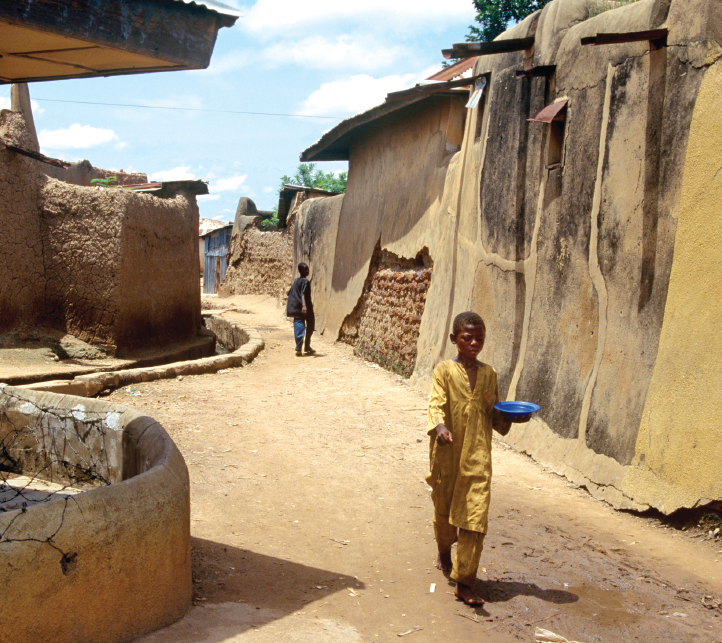
These family homes with baked clay walls are in the ancient city of Zaria, in Nigeria.
The family often lives in a compound. This is a homestead , sometimes surrounded by wattle fences or brick walls. The extended family makes it easier for adults to work and raise children. It is harder to keep this culture in cities, where many people live in high-rise apartments and cramped shantytowns . Some families now prefer to live in smaller groups.
Each person knows his or her role and duty. This is especially true in communities that are organized into traditional age grades . Each age grade marks a life stage and lasts from 8 to 15 years. This is very different from grades in school, which last for just a year. In age grades, everyone is given responsibilities according to his or her grade. Age grade systems are used mainly in East Africa but also in some West African societies, such as the Bambara and Igbo. Age grades and their rules are not as strict as they once were.
Among some peoples, boys and men and occasionally girls move through their grades together in a group called an age set . Age sets last for life and are often given names such as Leopard or Thunder. In Kenya and Tanzania, Masai boys move up to the moran warrior life stage in their teenage years. Here, they learn cattle-keeping skills and Masai traditions .
There is a strong culture of kinship across Africa. It often begins with the clan , which is a group of families or villages that share a common language and culture. Each clan or clan group might be led by a committee of senior men called elders . Elders help sort out family disagreements and land disputes.
Font size:
Interval:
Bookmark:
Similar books «African Culture»
Look at similar books to African Culture. We have selected literature similar in name and meaning in the hope of providing readers with more options to find new, interesting, not yet read works.
Discussion, reviews of the book African Culture and just readers' own opinions. Leave your comments, write what you think about the work, its meaning or the main characters. Specify what exactly you liked and what you didn't like, and why you think so.

